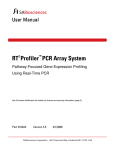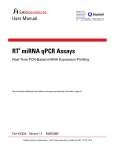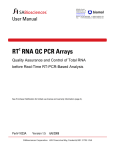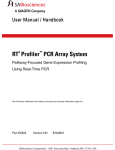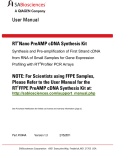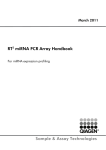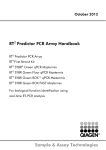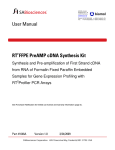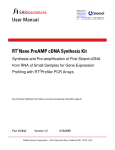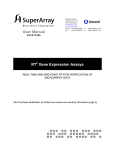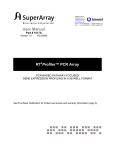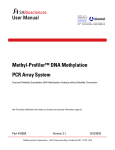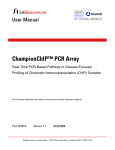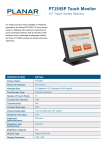Download User Manual - Biomol GmbH
Transcript
BIOMOL GmbH Waidmannstr. 35 22769 Hamburg [email protected] www.biomol.de Phone:+49-40-8532600 or 0800-2466651 (D) Fax: +49-40-85326022 or 0800-2466652 (D) User Manual 2 RT Profiler™ PCR Array System Pathway-Focused Gene Expression Profiling Using TaqMan® Probe-Based qPCR See Purchaser Notification for limited use license and warranty information (page 3). Part #1038 Version 1.0 10/24/2008 RT2 Profiler™ PCR Array System Pathway-Focused Gene Expression Profiling Using TaqMan® Probe-Based qPCR User Manual (For Catalog Numbers Prefixed by: HAHS) Ordering and Technical Service Contact Information: • • • • Tel: 1-888-503-3187 (US) 301-682-9200 (outside US) Fax: 1-888-465-9859 (US) 301-682-7300 (outside US) On-line Order: www.sabiosciences.com [email protected] To place an order E-MAIL: [email protected] For technical support You may place orders by fax, e-mail or from our website. Each order should include the following information: • • • • • Your contact information (name, phone, email address) Product name, catalog number and quantity Purchase order number or credit card information (Visa or MasterCard) Shipping address Billing address For more information, visit us at www.sabiosciences.com BIOMOL GmbH Waidmannstr. 35 22769 Hamburg [email protected] www.biomol.de Phone:+49-40-8532600 or 0800-2466651 (D) Fax: +49-40-85326022 or 0800-2466652 (D) SABioscience Corporation 6951 Executive Way Frederick, MD 21703 USA CONTENTS I. Background and Introduction 4 II. Materials Provided 6 III. Additional Materials Required 7 IV. Complementary Products 8 V. Protocol 9 VI. A. RNA Preparation and Quality Control 11 B. RT2 First Strand Kit 14 C. Performing Real-Time PCR 15 D. Data Analysis 19 Troubleshooting and Frequently Asked Questions 22 LIMITED PRODUCT WARRANTY This warranty limits our liability to replace this product in the event the product fails to perform due to any manufacturing defect. SABioscience Corporation makes no other warranties of any kind, expressed or implied, including without limitation, warranties of merchantability or fitness for a particular purpose. SABioscience Corporation shall not be liable for any direct, indirect, consequential or incidental damages arising out of the use, the results of use or the inability to use this product. NOTICE TO PURCHASER: LIMITED LICENSE Use of this product is covered by one or more of the following US patents and corresponding patent claims outside the US: 5,079,352, 5,789,224, 5,618,711, 6,127,155, 5,677,152 (Claims 1 to 23 only), 5,773,258 (Claims 1 and 6), 5,407,800, 5,322,770, 5,310,652, 5,210,015, 5,487,972, 5,804,375, 5,538,848, 5,723,591, 5,876,930, 6,030,787, 6,258,569, 6,214,979, and claims outside the US corresponding to US Patent No. 4,889,818. The purchase of this product includes a limited, non-transferable immunity from suit under the foregoing patent claims for using only this amount or product for the purchaser’s own internal research. No right under any other patent claim (such as apparatus or system claims in US Patent No. 6,814,934) and no right to perform commercial services of any kind, including without limitation reporting the results of purchaser’s activities for a fee or other commercial consideration, is conveyed expressly, by implication, or by estoppel. This product is for research use only. Diagnostic uses under Roche patents require a separate license from Roche. Further information on purchasing licenses may be obtained from the Director of Licensing, Applied Biosystems, 850 Lincoln Drive, Foster City, California 94404, USA. In addition, no rights are granted to use the components of this product for reproduction of any primer or probe, to modify product components for resale or to use the PCR Array to manufacture commercial products without written approval of SABioscience Corporation. U.S. patents may cover certain isolated DNA sequences included in PCR Array. Additional Patents are pending on the PCR Array System technology itself. 2 ® RT Profiler™ PCR Arrays, TaqMan Version I. Background and Introduction Real-time reverse transcription (RT) PCR (or qPCR) is the most sensitive and reliable method for gene expression analysis. Its wide dynamic range makes real-time RT-PCR the preferred choice for the simultaneous quantification of both rare and abundant genes in the same sample. The PCR Array takes advantage of real-time PCR performance and combines it with the ability of microarrays to detect the expression of many genes simultaneously. SABiosciences’ PCR Arrays are designed to analyze a panel of genes related to a disease state or biological pathway. The product is especially suitable for researchers who are more familiar with or prefer real-time PCR technology but are looking for the multi-gene profiling capabilities of a microarray. To complete the PCR Array procedure, start by converting your experimental RNA samples into first strand cDNA, the template for the polymerase chain reaction, using our RT2 First Strand Kit. (See Figure 1 for an overview of the PCR Array procedure.) Then, mix your template with one of our instrument-specific and ready-to-use qPCR Master Mixes. Aliquot the mixture into each well of the same plate containing pre-dispensed gene-specific qPCR assays. Perform qPCR, and determine relative expression using the ΔΔCt method with our free web based or downloadable data analysis templates. Each PCR array contains 84 pathway- or disease-focused genes, five housekeeping genes and three RNA and qPCR quality controls. The PCR Arrays are available in either a 96-well or 384-well plate format. (See Figure 2 for the PCR Array layout.) The PCR Arrays, Master Mixes, and first strand kit have been optimized hand-in-hand providing the complete system with superior sensitivity and wide linear dynamic ranges. The simplicity of the PCR Arrays makes them accessible for routine use in every academic or pharmaceutical research laboratory using laboratory equipment already available or equipment commonly found in core facilities. In addition, data analysis is quickly completed using either downloadable excel based templates or a web-based data analysis portal. Benefits of the PCR Arrays: • • • • Pathway Focused: Profile the expression of a panel of genes relevant to a pathway or disease state. Simple and Accurate: Simple real-time PCR procedure provides high sensitivity and wide dynamic range. Designed for Routine Use: Bring expression profiling any lab with a 96 or 384 well real-time PCR instrument. Data Analysis Templates: Quickly transform raw Ct values into fold change measurements using free data analysis templates. Combine microarray profiling capabilities with real-time qPCR performance! Technical Support: www.sabiosciences.com 4 [email protected] Version 1.0 Figure 1: Overview of the PCR Array Procedure Figure 2: TaqMan PCR Array Layout Wells A1 - G12 each contain a real-time TaqMan qPCR assay for genes from the same biological pathway or the same disease state or genes that are otherwise functionally-related. Wells H1 - H5 contain a housekeeping gene panel to normalize PCR Array data. The product information included with each cataloged TaqMan PCR Array contains a list of the pathway-focused and housekeeping genes on the array. Well H6 contains the Genomic DNA Control (GDC). Wells H7 through H9 contain replicate Reverse Transcription Controls (RTC). Wells H10 through H12 contain replicate Positive PCR Controls (PPC). The 384-well format of the TaqMan PCR Arrays includes four replicates of the same 96-well format, in which each two-by-two set of wells (wells labeled 1 - 4 in gray above) contains the same primer set represented by the 96-well designations. Technical Support: 888.503.3187 (US) 5 301.682.9200 2 ® RT Profiler™ PCR Arrays, TaqMan Version II. Materials Provided: The PCR Arrays are available in five different plate formats, each tailored to a specific subset of real-time PCR instruments and associated blocks. Formats A, C, D, and F are 96-well plates, while Formats E and G are 384-well plates. Format: For Real-Time Instruments: Plate: A All ABI “standard” blocks (7000, 7300, 7500, 7700, 7900) Bio-Rad iCycler, MyiQ, iQ5 Bio-Rad (MJ Research) Chromo 4 Eppendorf RealPlex Stratagene Mx3005p, Mx3000p 96-well C ABI 7500 and 7900HT FAST 96-well blocks ABI StepOnePlus™ 96-well D Bio-Rad (MJ Research) Opticon and Opticon 2 Stratagene Mx4000 96-well E ABI 7900HT 384-well block 384-well F Roche LightCycler 480 96-well block 96-well G Roche LightCycler 480 384-well block 384-well NOTE: The format of the PCR Array is indicated by the last letter of the catalog number. Be sure that you have the correct PCR Array format for your instrument before starting the experiment. The 96-well PCR Arrays (Formats A, C, D, and F) are shipped in sets of two (2), six (6) twelve (12), or twenty-four (24), while the 384-well PCR Arrays (Formats E and G) are shipped in sets of four (4). Each PCR Array shipment includes the arrays and either twelve (12) optical thin-wall 8-cap strips (Formats A and D) or one (1) optical adhesive film (Formats C, E, F, and G) per array. Storage Conditions: All components included in this kit are shipped at ambient temperature but must be stored at -20 °C upon receipt. When stored properly at -20 °C, their quality is guaranteed for 6 months. Technical Support: www.sabiosciences.com 6 [email protected] Version 1.0 III. Additional Materials Required: A. RNA Isolation Kit: See Page 12 for specific recommendations. B. RT2 First Strand Kit (Cat. No. C-03) MANDATORY for a Complete and Successful Experiment For Reverse Transcription Control Detection (RTC, Wells H7 through H9) C. SABiosciences’ RT2 qPCR Master Mix optimized for TaqMan detection MANDATORY for a Complete and Successful Experiment Be sure to pick the correct one for the instrumentation in your laboratory. 1. 96-Well PCR Arrays RT2 ROX qPCR Master Mix: Specifically designed for: All ABI and Stratagene Instrumentation Eppendorf Mastercycler® ep realplex Instruments WITH ROX filter set Catalog Number Size PA-017 For 2 PCR Arrays PA-017-12 For 12 PCR Arrays PA-017-24 For 24 PCR Arrays 2 RT Fluorescein qPCR Master Mix: Specifically designed for BioRad iCylcer®, MyiQ®, and iQ5 Instrumentation Catalog Number Size PA-016 For 2 PCR Arrays PA-016-12 For 12 PCR Arrays PA-016-24 For 24 PCR Arrays 2 RT qPCR Master Mix: Specifically designed for: BioRad (MJ Research) Chromo 4, Opticon, Opticon 2 Eppendorf Mastercycler® ep realplex Instruments WITHOUT ROX filter set Catalog Number Size PA-015 For 2 PCR Arrays PA-015-12 For 12 PCR Arrays PA-015-24 For 24 PCR Arrays 2. 384-Well PCR Arrays Each 384-well PCR Array 4-pack (Formats E & G) requires four (4) of the smaller size of the correct master mix for your instrument (4 X PA-01#). Technical Support: 888.503.3187 (US) 7 301.682.9200 2 ® RT Profiler™ PCR Arrays, TaqMan Version D. Equipment: 1. For recommendations on specific real-time instrumentation (thermal cyclers with fluorescent detection), see the list of master mixes and plate formats above. NOTE: The PCR Arrays can only be used in 96-well and 384-well real-time PCR instruments. PCR Arrays can not be used in the Cepheid SmartCycler®, the Roche LightCycler® 2.0, or the Corbett Research Rotorgene. 2. Calibrated Multi-Channel Pipettor 3. RNase / DNase-free pipette tips and tubes IV. Complementary Products: A. RT2 qPCR Primers, TaqMan Version Each gene assay offered on the PCR Array is offered as an individual assay for validation and follow-up studies. B. XpressRef™ Universal Total RNA: Universal RNA to control PCR conditions is available from the following species: Human XpressRef™ Universal Total RNA Mouse XpressRef™ Universal Total RNA Rat XpressRef™ Universal Total RNA Technical Support: www.sabiosciences.com 8 (Cat. No. GA-004) (Cat. No. GA-005) (Cat. No. GA-006) [email protected] Version 1.0 V. Protocol: Please read through this entire protocol before beginning your experiment. RNA samples are very sensitive to RNase digestion; therefore, wear gloves and maintain an RNase-free work area while performing this protocol. NOTE: Master Mix and First Strand Synthesis Considerations The performance of the TaqMan version of SABiosciences’ PCR Arrays is only guaranteed with the use of our RT2 qPCR Master Mixes and RT2 First Strand Kit. Therefore, the use of the complete PCR Array System for TaqMan detection is absolutely essential for obtaining accurate real-time qPCR profiling results. The chemically-modified and tightly controlled HotStart enzyme and other proprietary chemical components in our RT2 qPCR Master Mixes optimized for TaqMan detection uniquely provide more accurate results by preventing the amplification of primer dimers and other non-specific products that could effect the efficiency of each assay. They also help ensure high amplification efficiencies for genes with high GC content that tend to be the most difficult to quantitatively amplify. Because each instrument uses a different reference dye to normalize their optics, be sure that you use the correct master mix for the instrumentation in your laboratory. The RT2 First Strand Kit includes a proprietary buffer to eliminate any residual genomic DNA contamination in your RNA samples before it can be amplified into secondary products that would otherwise cause false positive signals. The Reverse Transcription Controls (RTC) on the PCR Array can only be evaluated with the built-in external RNA control of the RT2 First Strand Kit. These controls do not yield results when used with other sources of reverse transcriptases or first strand synthesis kits. The buffer components and the magnesium concentration in our RT2 First Strand Kit are also more compatible with our qPCR master mixes than other enzymes or kits providing the PCR Arrays with maximum levels of sensitivity with ng to μg amounts of total RNA. Technical Support: 888.503.3187 (US) 9 301.682.9200 2 ® RT Profiler™ PCR Arrays, TaqMan Version NOTE: Preparing a Workspace Free of DNA Contamination For accurate and reproducible PCR Array results, it is very important to avoid contamination of the assay with foreign DNA. The most common sources of DNA contamination are the products of previous experiments spread into the air of your working environment. Please follow the recommendations below on how to set up and maintain a working environment free of DNA contamination. 1. Wear gloves throughout the procedure. Use only fresh PCR-grade reagents (H2O) and lab ware (tips and tubes). 2. Physically separate the workspaces used for PCR setup and post-PCR processing or non-PCR operations. Decontaminate your PCR workspace and lab ware (pipettor barrels, tube racks, etc.) before each new use with UV light to render any contaminating DNA ineffective in PCR through the formation of thymidine dimers or with 10% bleach to chemically inactivate and degrade any DNA. 3. Close all tubes containing PCR products once you are finished adding or removing volumes. Before discarding any lab ware (tips or tubes) containing PCR products or other DNA, treat with 10% bleach. 4. Do not remove the PCR Array plate from its protective sealed bag until immediately ready to use. Do not leave lab ware (tubes and tip boxes) exposed to the air for long periods of time. 5. Do not open any previously run and stored PCR Array plate. Removing the thin-wall 8cap strips or the adhesive film from PCR Arrays releases PCR product DNA into the air where it will contaminate and confound the results of future real-time PCR experiments. Technical Support: www.sabiosciences.com 10 [email protected] Version 1.0 A. RNA Preparation and Quality Control: High quality RNA is ESSENTIAL for obtaining good real-time PCR results. The most important prerequisite for any gene expression analysis experiment is consistent, high-quality RNA from every experimental sample. Therefore, the sample handling and RNA isolation procedures are critical to the success of the experiment. Residual traces of proteins, salts or other contaminants will either degrade the RNA or decrease the efficiency of (if not block completely) the enzyme activities necessary for optimal reverse transcription and real-time qPCR performance. 1. Recommended RNA Preparation Methods: High quality total RNA for your real-time qPCR experiment must be prepared using one of the following methods, each specific for your biological sample: a. Cultured Cells: Use SABiosciences’ RT2 qPCR-Grade RNA Isolation Kit (Catalog # PA-001) or the Qiagen RNeasy® Mini Kit (Catalog # 74104). You must perform the recommended on-column DNase treatment step. b. Tissue Samples: i. First, extract RNA from the tissue using the TRIzol® protocol (Invitrogen, Catalog # 15596-026). Be sure to use a sufficient amount of TRIzol® reagent. During homogenization, add a volume of reagent at least ten times greater than the tissue volume. ii. Then, after the ethanol precipitation step, further clean up the RNA using SABiosciences’ RT2 qPCR-Grade RNA Isolation Kit (Catalog # PA-001) or the Qiagen RNeasy® Mini Kit (Catalog # 74104). You must perform the recommended on-column DNase treatment step. c. Whole Blood Samples: i. Before RNA preparation, red blood cells (RBC) must be removed from whole blood samples using a density gradient centrifugation medium (for example, Lymphoprep, Greiner Bio-One, Catalog # 1031966). ii. The white blood cell fraction is then used for RNA isolation with SABiosciences’ RT2 qPCR-Grade RNA Isolation Kit (Catalog # PA-001) or the Qiagen RNeasy® Mini Kit (Catalog # 74104). You must perform the recommended on-column DNase treatment step. iii. Alternatively, the PAXgene Blood RNA Kit (Qiagen, Catalog # 762164) can also be used to prepare total RNA from whole blood samples. d. Total RNA Isolated Using a Phenol-Based Method: If you have already prepared total RNA from any biological source material using a phenol-based method (such as TRIzol®, RNAzol, etc.), you must clean up the RNA with SABiosciences’ RT2 qPCR-Grade RNA Isolation Kit (Catalog # PA-001) or the Qiagen RNeasy® Mini Kit (Catalog # 74104). You must perform the recommended on-column DNase treatment step. e. For Other Biological Samples: Refer to the existing literature to find isolation protocols for high-quality RNA from other biological samples or contact one of our Technical Support representatives. Technical Support: 888.503.3187 (US) 11 301.682.9200 2 ® RT Profiler™ PCR Arrays, TaqMan Version For best results from the PCR Array, all RNA samples should be suspended in the RNasefree water provided with the RNA Isolation kit. DO NOT use DEPC-treated water! 2. RNA Quality Control: For best results from the PCR Array, all RNA samples should also demonstrate consistent quality according to the following criteria: a. RNA Concentration and Purity by UV Spectrophotometry NOTE: Prepare dilutions and measure absorbance in 10 mM Tris, pH 8.0 buffer. The spectral properties of nucleic acids are highly dependent on pH. i) A260:A230 ratio should be greater than 1.7. ii) A260:A280 ratio should be greater than 2.0. iii) Concentration by A260 should be greater than 4 μg / ml total RNA b. Ribosomal RNA band integrity Electrophorese a fraction of each RNA sample on a denaturing agarose gel or on an Agilent BioAnalyzer using an RNA 6000 Nano LabChip® and verify that there is a sharp distinction at the small side of both the 18S and 28S ribosomal RNA (rRNA) bands or peaks. Any smearing or shoulder to the rRNA bands or peaks indicates that degradation has occurred in the RNA sample. A B MW RNA 28S 18S Figure 3: Good Ribosomal RNA Band Integrity Is Important for Optimal PCR Array Results. Panel A displays an Agilent BioAnalyzer electropherogram of a high-quality total RNA preparation showing sharp peaks without shoulders (especially to the left of each peak) for the 18S and 28S ribosomal RNA (left to right). Panel B, right-hand lane, displays an analysis of the same high-quality total RNA preparation by agarose gel electrophoresis demonstrating sharp bands (especially at the bottom of each band) for the 28S and 18S ribosomal RNA (top to bottom). Because some contaminants are difficult to detect by simply looking at RNA integrity and can be missed by UV spectrophotometry, it is essential to choose the proper RNA isolation method for your biological sample as described above. Technical Support: www.sabiosciences.com 12 [email protected] Version 1.0 3. Genomic DNA Contamination: Eliminating genomic DNA contamination is essential for obtaining optimal real-time gene expression profiling results using the PCR Array. The Genomic DNA Control (GDC) in each PCR Array specifically and sensitively tests for genomic DNA contamination in each sample during each run. A GDC threshold cycle value less than 35 indicates the presence of a detectable amount of genomic DNA contamination that should be addressed. Guaranteeing that this control will pass REQUIRES performing the on-column DNase treatment step in the RT2 qPCR-Grade RNA Isolation Kit (PA-001) or the Qiagen RNeasy® Mini Kit (Catalog # 74104) followed by using the RT2 First Strand Kit (C-03) to remove any and all residual contamination from your RNA samples. 4. Amount Considerations: The PCR Array System yields results with as little as 100 ng or as much as 5 μg total RNA per array. However, the optimal amount of starting material depends on the relative abundance of the transcripts of interest. Lower abundance transcripts require more RNA; higher abundance transcripts require less RNA. Greater amounts of input total RNA yield a greater number of positive calls; that is, genes expressed in the linear dynamic range of the method. Lower amounts of input total RNA yield a smaller number of positive calls and increase false negative calls. The use of the RT2 First Strand Kit (C-03) maximizes the number of positive calls at low amounts (100 ng) of total RNA over other sources of reverse transcriptase and first strand synthesis kits. For successful results and maximum positive call rates, we recommend that first time users try starting with anywhere from 0.5 μg to 1.0 μg of total RNA. It is also important to use a consistent amount of total RNA for all samples in a single experiment to be characterized and compared. Technical Support: 888.503.3187 (US) 13 301.682.9200 2 ® RT Profiler™ PCR Arrays, TaqMan Version 2 B. RT First Strand Kit (C-03) NOTE: The use of SABiosciences’ RT2 First Strand Kit (Cat. No. C-03) is critical for detecting the Reverse Transcription Controls (RTC, Wells H7-H9) and for obtaining the best results from the PCR Array. For more information on the importance of this kit, refer to the notes found on Pages 10 and 14. NOTE: RNA samples must meet the standards of integrity and purity from protein, organics, and genomic DNA contamination described on the previous two pages. 1. Genomic DNA Elimination Mixture: a. For each RNA sample, combine the following in a sterile PCR tube: Total RNA 100 ng to 5.0 μg GE (5X gDNA Elimination Buffer) 2.0 μl μl RNase-free H2O to a final volume of … 10.0 NOTE: Use the same amount of total RNA in this reaction for every sample. First time users are recommended to start with 0.5 or 1.0 μg of total RNA for 96-well plate formats or with 0.2 to 0.5 μg of total RNA for 384-well plate formats. b. Mix the contents gently with a pipettor followed by brief centrifugation. c. Incubate at 42 °C for 5 min. d. Chill on ice immediately for at least one minute. 2. Prepare the RT Cocktail: 1 reaction 2 reactions 4 reactions 4 μl 8 μl 16 μl 1 μl 2 μl 4 μl 2 μl 4 μl 8 μl 3 μl 6 μl 12 μl 10 μl 20 μl 40 μl RT Cocktail BC3 (5X RT Buffer 3) P2 (Primer & External Control Mix) RE3 (RT Enzyme Mix 3) RNase-free H2O Final Volume 3. First Strand cDNA Synthesis Reaction: a. Add 10 μl of RT Cocktail to each 10-μl Genomic DNA Elimination Mixture. b. Mix well but gently with a pipettor. c. Incubate at 42 °C for exactly 15 min and then immediately stop the reaction by heating at 95 °C for 5 minutes. d. Add 91 μl of ddH2O to each 20-μl of cDNA synthesis reaction. Mix well. e. Hold the finished First Strand cDNA Synthesis Reaction on ice until the next step or store overnight at -20 °C. Technical Support: www.sabiosciences.com 14 [email protected] Version 1.0 C. Performing Real-Time PCR: NOTE: The use of SABiosciences’ RT2 qPCR Master Mixes optimized for TaqMan detection is critical for obtaining the most accurate results from the PCR Array. Be sure to use the correct master mix for your instrument before continuing with this protocol (See Pages 8 and 10). NOTE: An incorrectly chosen PCR Array plate format will not properly fit into your real-time PCR instrument, and its use will damage the instrument. Be sure you have the correct PCR Array format for your instrument before continuing with this protocol (See Page 7). NOTE: The accuracy and precision of your pipetting determine the consistency of your results. Be sure that all of your micro-pipettors are calibrated before beginning this procedure. Also, make sure to not introduce any bubbles into the wells of the PCR Array. 1. Experimental Cocktail Preparation: Plate Format: RT2 qPCR Master Mix, TaqMan Optimzed Diluted First Strand cDNA Synthesis Reaction ddH2O Total Volume 96-well A, C, D, & F 1275 μl 102 μl 1173 μl 2550 μl 384-well E&G 550 μl 102 μl 448 μl 1100 μl NOTE: This recipe provides a limited excess volume. Very carefully add the cocktail to the PCR Array precisely as described below to insure that each well receives the required volume. NOTE: Save the remaining 9 μl of the cDNA synthesis reaction at -20 °C in case it is needed for troubleshooting purposes. 2. Loading the 96-Well PCR Array Formats A, C, D, or F: a. CAREFULLY remove the PCR Array from its sealed bag. b. Add 25 μl of the Experimental Cocktail to each well of the PCR Array, preferably from a reservoir with an eight-channel pipettor (or a twelve-channel pipettor but only using eight tips). NOTE: Change pipet tips following each addition to avoid any cross-contamination between the wells or reactions. c. Skip the next page and proceed to “Performing Real-Time PCR Detection” below. Technical Support: 888.503.3187 (US) 15 301.682.9200 2 ® RT Profiler™ PCR Arrays, TaqMan Version 3. Loading the 384-Well PCR Array Formats E or G: NOTE: Each 384-well plate characterizes four samples in separate sets of 96-wells staggered from one another by only one well. The spacing between the tips of standard multi-channel pipettors will allow you to properly skip rows or columns when adding each sample. Be sure to load each sample into the correct set of wells. Use Figure 4 as a guide. a. CAREFULLY remove the PCR Array from its sealed bag. b. Add 10 μl of each sample’s Experimental Cocktail to the appropriate wells of the PCR Array, preferably from a reservoir with an eight- channel pipettor (or a twelvechannel pipettor but only using eight tips). NOTE: Change pipet tips following each addition to avoid any cross-contamination between the wells or reactions. Sample #1 Sample #2 Sample #3 Sample #4 Figure 4: To load a 384-well format PCR Array, add 10 μl of the Experimental Cocktail from each numbered sample into the staggered wells with the same number as indicated in the figure. c. Proceed to the next section, “Performing Real-Time qPCR Detection” below. NOTE: Change pipet tips following each addition to avoid any cross-contamination between the wells or reactions. Technical Support: www.sabiosciences.com 16 [email protected] Version 1.0 5. Performing Real-Time qPCR Detection: NOTE: Be sure to follow the manufacturer’s instructions for the proper operation and maintenance of your real-time instrument. a. CAREFULLY but tightly seal the PCR Array with the optical thin-wall 8-cap strips (Formats A and D) or with the optical adhesive film (Formats C, E, F, and G). NOTE: Be sure that no bubbles appear in any of the wells of the PCR Array. To remove bubbles, tap the plate gently on the bench top or centrifuge the plate briefly. b. Place the plate on ice while setting up the PCR cycling program below. c. Place one plate in your real-time thermal cycler. If recommended by your instrument’s user manual, use a compression pad with the optical film-sealed plate formats. NOTE: PCR Arrays containing experimental cocktail may be stored at 4°C wrapped in aluminum foil for 24 hours. d. Enter and run the appropriate program for your real-time instrument (below). If prompted by your instrument software, select “Absolute Quantization” to begin. NOTE: For additional help with instrument setup, see our Instrument-Specific Setup Instructions and Protocol Files at: http://www.sabiosciences.com/taqmanpcrarrayprotocolfiles.php A two-step cycling program is used on all real-time PCR instrumentation: Cycles 1 45 1 2 Duration 10 minutes1 15 seconds 1 minute2 Temperature 95 °C 95 °C 60 °C The 10-minute step at 95 °C is required to activate the HotStart DNA polymerase. Detect and record the FAM fluorescence from every well during the annealing step of each cycle. Technical Support: 888.503.3187 (US) 17 301.682.9200 2 ® RT Profiler™ PCR Arrays, TaqMan Version e. Calculate the threshold cycle (Ct) for each well using the instrument’s software. i. Automatic settings that use threshold based baseline values, or automatic baseline correction can be used; however, we recommend manually setting the threshold values. Depending on the instrument used, other settings such as curve smoothing may need to be adjusted. Consult your instrument’s manual or contact SABiosciences’ customer support for help with specific instruments. ii. To define the Threshold Value, use the Log View of the amplification plots and place it above the background signal but within the lower one-third to lower onehalf of the linear phase of the amplification plot. iii. IMPORTANT: Ensure that the thresholds are the same across all PCR Array runs in the same analysis. The absolute position of the threshold is less critical than its consistent position across arrays. If the RNA sample quality has been adequately controlled, the cycling program has been executed properly, and the thresholds have been defined correctly, then the value of CtPPC should be 20 ± 2 across all of your arrays or samples. If not, see the Troubleshooting and FAQ section. iv. Export the resulting threshold cycle values for all wells to a blank Excel spreadsheet for use with our Data Analysis Template Excel file. Technical Support: www.sabiosciences.com 18 [email protected] Version 1.0 D. Data Analysis: ΔΔCt Method NOTE: PCR Array Data Analysis Web Portal Access our free PCR Array Data Analysis Web Portal from the following address: http://www.SABiosciences.com/pcrarraydataanalysis.php The PCR Array Data Analysis Web Portal automatically performs the following calculations and interpretation of the control wells upon including threshold cycle data from a real-time instrument. The PCR Array Data Analysis Web Portal presents the results in a tabular format, a scatter plot, a three-dimensional profile, and a volcano plot (when replicates are included). 1. Change all Ct values reported as greater than 35 or as N/A (not detected) to 35. At this point, any Ct value equal to 35 is considered a negative call. 2. Examine the threshold cycle values of the control wells. a. Genomic DNA Control (GDC): i. Calculate CtGDC. ii. If the value is greater than 35, then the level of genomic DNA contamination is too low to affect gene expression profiling results. No action is needed. iii. If the value is less than 35, then genomic DNA contamination is evident. See the Troubleshooting and FAQ section. b. Reverse Transcription Control (RTC): Any impurities in your RNA sample that affect the reverse transcription of the RT2 First Strand Kit’s built-in external RNA control also affect the reverse transcription of your messages of interest. i. Calculate ΔCt = AVG CtRTC – AVG CtPPC. ii. If this value is less than 7, then no inhibition is apparent. iii. If this value is greater than 7, then evidence of impurities that inhibited the reverse transcription phase of the procedure is evident. See the Troubleshooting and FAQ section. Technical Support: 888.503.3187 (US) 19 301.682.9200 2 ® RT Profiler™ PCR Arrays, TaqMan Version c. Positive PCR Control (PPC): Any impurities in your RNA sample that affect the PCR amplification of the positive control also affect the PCR amplification for your messages of interest. i. The average CtPPC value should be 20 ± 2 on each PCR Array and should not vary by more than two cycles between PCR Arrays being compared. ii. Larger differences in average CtPPC values between samples indicate the presence of different amounts of PCR amplification inhibitors in each sample and that all of the RNA samples require further purification. iii. An average value of CtPPC that is consistently greater than 22 for all of your samples may indicate a problem with the cycling conditions or may simply be indicative of the relative sensitivity of your instrument. See the Troubleshooting and FAQ section. 3. Calculate the ΔCt for each pathway-focused gene in each plate. ΔCt = CtGOI –CtAVG HKG NOTE: Choosing the right normalization factor The expression level of the housekeeping genes chosen for normalization in the ΔΔCt method must not be influenced by your experimental conditions. If one or more such genes have been previously identified by independent means and if the PCR Array reproduces those results, use the average of their Ct values in the equation above. If an appropriate housekeeping gene has not been previously identified, use the average Ct value of all housekeeping genes. Or, simply use zero (0) in the place of the average of HK genes’ Ct for each group to be compared, and rely on the consistency in the quantity and quality of your original input total RNA across your groups to effectively normalize your results. 4. When biological and/or technical replicates are performed, calculate the average ΔCt value of each gene (each well) across those replicate arrays for each treatment group. 5. Calculate the ΔΔCt for each gene across two PCR Arrays (or groups). ΔΔCt = ΔCt (group 2) - ΔCt (group 1) Where group 1 is the control and group 2 is the experimental 6. Calculate the fold-change for each gene from group 1 to group 2 as 2 ^ (-ΔΔCt). OPTIONAL: If the fold-change is greater than 1, then the result may be reported as a fold up-regulation. If the fold-change is less than 1, then the negative inverse of the result may be reported as a fold down-regulation. The fold-change ratios may also be reported as is. Technical Support: www.sabiosciences.com 20 [email protected] Version 1.0 NOTE: Detailed Mathematical Explanation of ΔΔCt Data Analysis Method Due to the inverse proportional relationship between the threshold cycle (Ct) and the original gene expression level, and the doubling of the amount of product with every cycle, the original expression level (L) for each gene of interest is expressed as: To normalize the expression level of a gene of interest (GOI) to a housekeeping gene (HKG), the expression levels of the two genes are divided: To determine fold change in gene expression, the normalized expression of the GOI in the experimental sample is divided by the normalized expression of the same GOI in the control sample: The complete calculation is as follows: Technical Support: 888.503.3187 (US) 21 301.682.9200 2 ® RT Profiler™ PCR Arrays, TaqMan Version VI. Troubleshooting and FAQs A. Troubleshooting: 1. Removal of Genomic DNA Contamination: You must perform the on-column DNase treatment step included in the protocol of SABiosciences’ RT2 qPCR-Grade RNA Isolation Kit (PA-001) or Qiagen’s RNeasy® Mini Kit (Catalog # 74104). You must also then use SABiosciences’ RT2 First Strand Kit (C-03) with its genomic DNA elimination step. If the genomic DNA contamination proves difficult to remove, fold-changes in gene expression may still be obtained. However, it will then be very important to validate any results for individual genes by a separate more rigorous real-time PCR analysis that includes a “minus RT” control. Apparent genomic DNA contamination may also indicate evidence of more general DNA contamination of other reagents, tips, and tubes. See the Note about Preparing a Workspace Free of DNA Contamination at the beginning of the protocol in this User Manual. 2. Improving Poor Reverse Transcription Efficiency: Double-check the A260:A280 and A260:A230 ratios of your RNA samples and be sure to perform the dilutions for spectrophotometry in RNase-free Tris pH 8.0 buffer. If necessary, re-purify your RNA samples with a spin-column based clean up method, such as SABiosciences’ RT2 qPCR-Grade RNA Isolation Kit (PA-001) or Qiagen’s RNeasy® Mini Kit (Catalog # 74104). Technical Support: www.sabiosciences.com 22 [email protected] Version 1.0 3. Improving Poor PCR Amplification Efficiency: Different instruments have different levels of sensitivity. If an average CtPPC value of 20 ± 2 is difficult to obtain for your instrument, the observed average CtPPC value should be acceptable as long as it does not vary by more than two cycles between PCR Arrays being compared. Be sure that the initial heat activation step at 95 °C has been lengthened to 10 minutes from the shorter time in the default program. Be sure that all other cycle parameters also have been correctly entered according to the recommendations in this User Manual. Also, double check the quality of your RNA as described in “Evidence of Poor Reverse Transcription Efficiency” above. B. Frequently Asked Questions: 1. Will pipetting error affect the PCR Array results? The passive reference dyes in the master mixes, such as ROX and Fluorescein, are used by the real-time PCR systems to normalize variation from well to well. Therefore, these systems tolerate volume variations caused by pipetting error and evaporation. 2. How can I prevent the evaporation of reaction volume from the wells? Be sure to carefully and completely seal the PCR Array with the optical thin-wall 8-cap strips or the optical adhesive film before placing it into your thermal cycler. Also, be sure to use a compression pad with the plate formats using the optical film seal (Formats C, E, F and G) as directed by the manufacturer of your real-time PCR instrument. 3. How reliable are the results from the PCR Array? Assuming the use of good, consistent experimental technique, real-time PCR methods such as the PCR Array provide very reproducible results. To insure the reliability of your results and to reliably detect smaller fold changes in gene expression from the PCR Array, the performance of replicate determinations (such as biological triplicates) is highly recommended. The Data Analysis Template available from our website for the PCR Array uses your replicate PCR Array data to calculate t-test p values and to generate a “Volcano Plot” illustrating the statistically significant fold-changes in gene expression. If you have additional questions, please check our website (www.SABiosciences.com) for a more complete listing of Frequently Asked Questions (FAQs), or call our Technical Support Representatives at 1-888-503-3187 or 301-682-9200. StepOnePlus™ is a trademark of Applied Biosystems. iCycler® and MyiQ® are registered trademarks of BioRad Laboratories, Inc. LabChip® is a registered trademark of Caliper Life Sciences. LightCycler® and TaqMan® is a registered trademark of Roche Applied Sciences. SmartCycler® is a registered trademark of Cepheid. TRIzol ® is a registered trademark of Invitrogen. Mastercycler® is a registered trademark of Eppendorf. Technical Support: 888.503.3187 (US) 23 301.682.9200 ® RT2 Profiler™ PCR Array, TaqMan Version, User Manual Part #1038 Version 1.0 BIOMOL GmbH Waidmannstr. 35 22769 Hamburg [email protected] www.biomol.de Phone:+49-40-8532600 or 0800-2466651 (D) Fax: +49-40-85326022 or 0800-2466652 (D) 10/24/2008

























